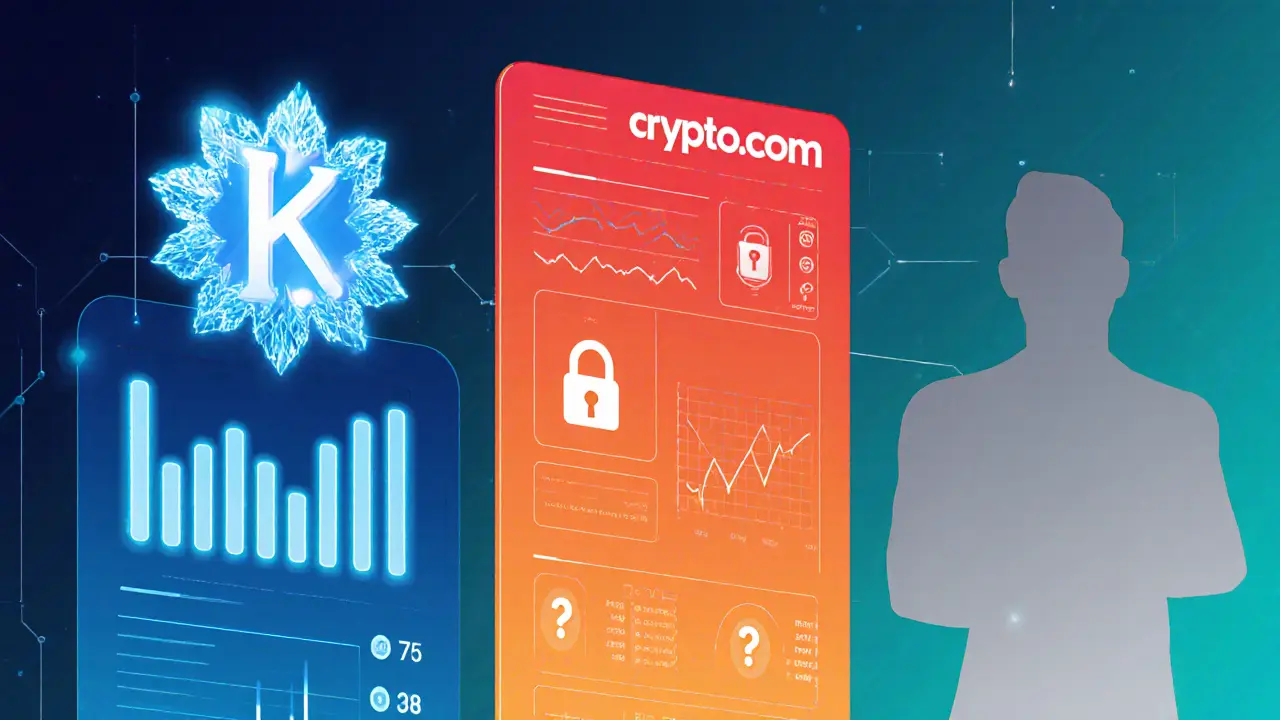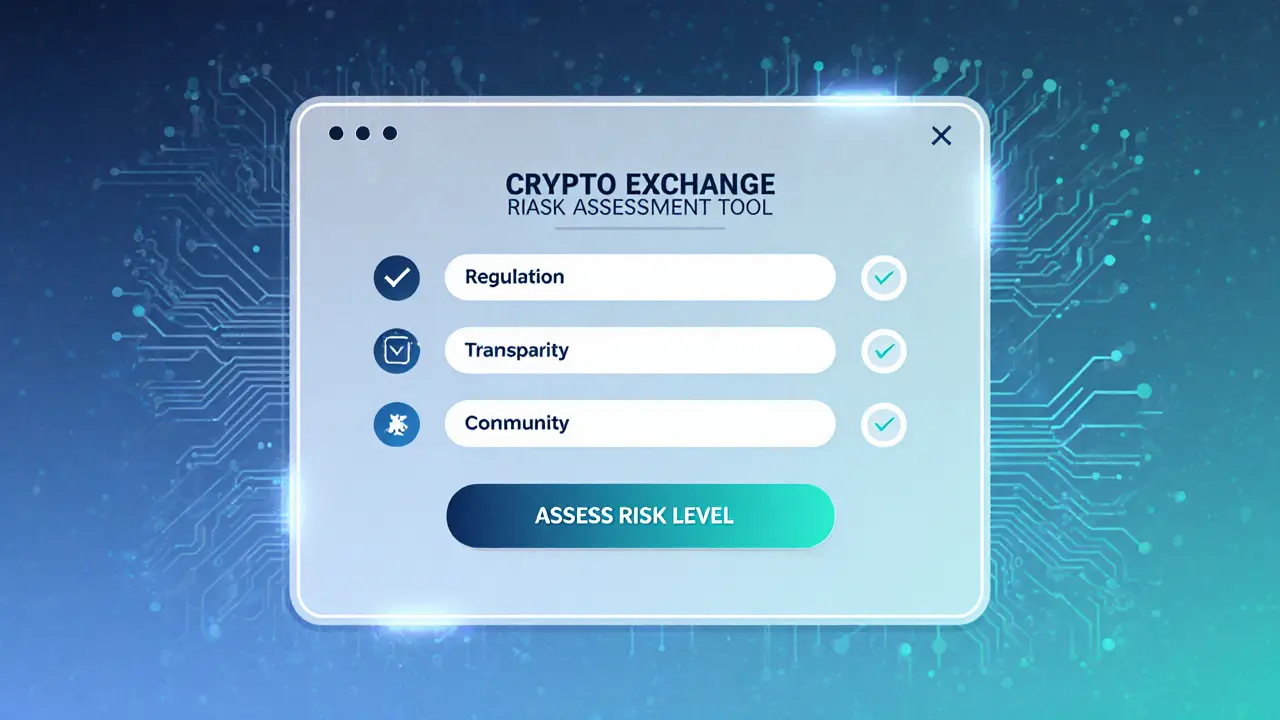TWCX Crypto Exchange Risk Assessment Tool
Exchange Overview
This tool helps assess the risk level of TWCX based on critical factors typically found in established cryptocurrency exchanges.
Risk Assessment Result
Comparison with Established Exchanges
Below is a comparison showing how TWCX compares against known exchanges like Kraken and Crypto.com across key metrics.
| Feature | TWCX | Kraken | Crypto.com |
|---|---|---|---|
| Founded | Unknown | 2011 | 2016 |
| Supported Coins | Not disclosed | 120+ | 250+ |
| Daily Volume | Not reported | $2.4B | $1.9B |
| Maker/Taker Fees | Unknown | 0-0.26% | 0-0.4% |
| Security Highlights | None published | Cold storage 95%, 2FA mandatory | Cold storage 98%, insurance fund $200M |
| Regulatory Status | Unclear | Licensed in US, EU, Japan | Licensed in US, Singapore, UK |
| Customer Support | Not listed | 24/7 live chat, ticketing | Live chat, phone, in-app help |
TWCX is a cryptocurrency exchange that appears in a handful of online references as a platform for virtual currency trading. The only concrete description comes from WikiBit, which calls it a "reliable platform for users to engage in virtual currency exchange." Beyond that brief line, publicly available data is virtually nonexistent.
Quick Take
- Information on TWCX is extremely limited; no official website, fee schedule, or supported asset list is publicly documented.
- Security details, regulation status, and user experience are unknown.
- Established exchanges such as Kraken and Crypto.com provide transparent specs, making them safer default choices.
- Proceed with caution and treat TWCX as a high‑risk, unverified platform.
What Is TWCX?
The name suggests a standalone exchange, but there is no clear corporate identity, founding date, or leadership information. No registration details with any financial regulator (e.g., FCA, FinCEN, or the New Zealand Financial Markets Authority) have surfaced in public records. The lack of a verifiable KYC or AML framework raises immediate compliance questions.
Available Information
The only citation of TWCX comes from a short WikiBit entry that labels the service as "reliable" but offers no metrics-no trading volume, no liquidity data, no list of supported coins. No press releases, blog posts, or social‑media channels have been identified. Even a search for a domain name matching "twcx.com" or "twcx.io" returns parked pages or unrelated businesses.
What’s Missing? The Data Gaps
When evaluating any exchange, you normally look for these criteria:
- Supported cryptocurrencies (e.g., Bitcoin, Ethereum)
- Trading pairs and order‑type variety (market, limit, stop‑loss)
- Fee structure (maker/taker rates, withdrawal fees)
- Security measures (cold storage %, two‑factor authentication, insurance fund)
- Regulatory compliance (licenses, jurisdiction)
- Customer support channels (live chat, ticket system, response time)
- Liquidity and daily trading volume
For TWCX, none of these items have been documented. That makes any risk assessment speculative at best.

How It Stacks Up Against Known Exchanges
| Feature | TWCX | Kraken | Crypto.com |
|---|---|---|---|
| Founded | Unknown | 2011 | 2016 |
| Supported Coins (approx.) | Not disclosed | 120+ | 250+ |
| Daily Volume (24h) | Not reported | $2.4B | $1.9B |
| Maker/Taker Fees | Unknown | 0‑0.26% | 0‑0.4% |
| Security Highlights | None published | Cold storage 95%, 2FA mandatory | Cold storage 98%, insurance fund $200M |
| Regulatory Status | Unclear | Licensed in US, EU, Japan | Licensed in US, Singapore, UK |
| Customer Support | Not listed | 24/7 live chat, ticketing | Live chat, phone, in‑app help |
The table makes it obvious that TWCX currently lacks the transparency that traders expect from reputable platforms. While the “unknown” column doesn’t automatically mean the exchange is unsafe, it does signal a high information asymmetry.
Red Flags and Risk Considerations
In the crypto world, the absence of data is itself a data point. Here are the main warning signs:
- No verifiable corporate entity: Without a registered company, legal recourse is limited.
- No publicly audited security audits: Most reputable exchanges publish third‑party audit reports.
- Missing KYC/AML details: Regulators worldwide are cracking down on anonymous platforms.
- Lack of community chatter: Platforms with active user bases generate discussion on Reddit, Twitter, and Telegram. TWCX is virtually silent.
- Potential confusion with defunct WCX: WCX was exposed as a scam in 2020. Even though TWCX is a different name, the similarity can cause brand‑trust issues.
Should You Try TWCX?
If you’re an experienced trader who thrives on high‑risk, low‑information opportunities, you might allocate a tiny portion of your portfolio-say, less than 1%-to test a small deposit. However, for most users, the safer route is to stick with exchanges that publish clear fee schedules, security practices, and regulatory licenses.
Always perform a “sandbox” test: create an account, go through the verification flow, and withdraw a tiny amount before committing any significant capital.
Next Steps for Cautious Users
- Search for an official website or app store listing that matches the TWCX brand.
- Check the domain’s WHOIS record for registration date and owner.
- Look for third‑party reviews on trusted sites like CoinDesk, CryptoCompare, or Trustpilot.
- Verify whether the platform is listed on any government or financial regulator’s “registered exchanges” directory.
- If you decide to proceed, start with the smallest possible trade, enable all security features (2FA, withdrawal whitelist), and monitor the experience closely.
Bottom Line
The current public record on TWCX crypto exchange review is a thin shred of information that barely sketches the platform’s existence. In contrast, industry leaders such as Kraken and Crypto.com provide detailed documentation that lets users evaluate risk with confidence. Until TWCX publishes concrete data-fees, security policies, jurisdiction, and user support-treat it as a high‑risk, unverified service.

Frequently Asked Questions
Is TWCX a legitimate crypto exchange?
There is no publicly verifiable information confirming TWCX’s legal status, licensing, or corporate registration. Without such evidence, its legitimacy remains uncertain.
What cryptocurrencies does TWCX support?
The platform does not disclose a public list of supported assets. No official documentation lists Bitcoin, Ethereum, or any altcoins.
How can I verify the security of TWCX?
Security details such as cold‑storage percentages, audit reports, or insurance funds have not been published. Without third‑party audits, you cannot verify the platform’s safeguards.
Is TWCX regulated in any jurisdiction?
No regulator lists TWCX as a licensed exchange. This absence suggests it may operate without formal oversight.
Should I move my funds from a trusted exchange to TWCX?
Given the lack of transparent information, it is advisable to keep the bulk of your holdings on established platforms that provide clear fee schedules, security audits, and regulatory compliance.


16 Responses
I appreciate the thoroughness of the risk assessment; the lack of transparency is quite concerning. It’s prudent to prioritize exchanges with clear regulatory compliance.
From a systems‑theoretic perspective, the absence of documented asset listings constitutes a significant epistemic opacity, which undermines the exchange's epistemic reliability. Moreover, without verifiable KYC/AML pipelines, the platform flouts AML best practices, which is a red flag for institutional risk managers. In the realm of cryptographic custodial solutions, cold storage ratios and multi‑sig protocols serve as essential security primitives; their omission here precludes any meaningful risk‑adjusted return calculations. The comparative table highlights a stark asymmetry: established venues like Kraken and Crypto.com disclose fee matrices, daily volume metrics, and audit attestations, facilitating a data‑driven decision framework. Conversely, the 'unknown' entries for TWCX effectively function as a null hypothesis that demands rigorous falsification before capital allocation. Regulatory licensing is another non‑negotiable vector; operating under an unlicensed jurisdiction escalates exposure to legal uncertainty and potential enforcement actions. The market microstructure of TWCX remains opaque: no order‑type granularity, no depth charts, no public API documentation-this impedes algorithmic trading strategies that rely on latency arbitrage. Additionally, user support channels are a critical component of operational resilience; the lack thereof suggests potential service degradation under stress scenarios. Security audits, ideally third‑party, provide an assurance baseline that is conspicuously missing, raising concerns about susceptibility to supply‑chain attacks. In sum, the cumulative deficits across compliance, security, transparency, and liquidity dimensions coalesce into a high‑risk profile that warrants only minimal exposure, if any, from a portfolio construction standpoint.
Wow, another mystery exchange popping up out of nowhere!!! It’s like they think we won’t notice the glaring gaps!!! Without a website, fees, or even a Twitter-how can anyone trust this!!!
Oh, brilliant-let’s all throw our life savings at a platform that can’t even be Googled. Sure, high‑risk sounds thrilling if you enjoy gambling on the dark web.
Hey folks! 🌟 Even if you’re curious, start with a tiny test deposit-maybe $5‑$10-and see how the verification flow works. If the process feels sketchy, it’s a sign to back off. Remember, crypto is volatile, so protect your capital! 🚀
Sure, because nothing says "secure" like a platform that hides everything.
From a user‑experience standpoint, clear fee schedules and support channels are essential. Without them, you’re essentially flying blind, which can lead to costly mistakes. I’d advise anyone considering TWCX to first verify its compliance documents, if they exist. A cautious approach-small test trades, enable 2FA, and monitor withdrawals-can mitigate some risk.
Sounds risky 🤔
Let’s be real: no one’s going to hand over money to a black box. If you’re a thrill‑seeker, maybe, but most of us need data.
This looks like a classic case of “too good to be true.” I’d stick with platforms that are open about their fees and security. It’s better to be safe than sorry.
Adding to what Marie said, the crypto community thrives on shared information. If an exchange isn’t listed on reputable aggregators, it’s a red flag. I’d recommend checking forums and trust scores before any commitment.
No info, no go.
Esteemed colleagues, the paucity of verifiable data regarding TWCX necessitates a cautious posture. In the absence of audited security protocols, the probability of compromise escalates dramatically. Moreover, the regulatory vacuum engenders heightened legal exposure for participants. It would be prudent to allocate only a negligible fraction of capital, should one elect to experiment. Ultimately, the onus lies upon the investor to conduct exhaustive due diligence prior to any engagement.
Did you know some “exchanges” are front‑ends for invisible Ponzi schemes? The lack of a WHOIS record suggests a deliberately hidden operator. It’s possible they’re funneling funds to an offshore shell. This should set off every risk alarm.
Honestly, I’d steer clear unless I saw some concrete proof of security measures. The crypto space is already messy enough.
Well, if you’re comfortable with total opaqueness, go ahead-just don’t blame the rest of us when it vanishes.